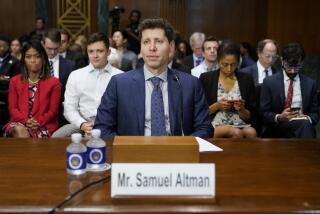J. Robert Beyster dies at 90; founder of defense giant SAIC
- Share via
J. Robert Beyster, who founded a technology startup with $10,000 and a half-dozen employees and turned it into a multibillion-dollar-a-year defense contractor with 43,000 employees worldwide, has died. He was 90.
Beyster died Monday at his home in La Jolla after several years of declining health, his family announced.
The San Diego-based company he founded in 1969 became best known for its initials, SAIC, for Science Applications International Corp. A quiet, unassuming Midwesterner, Beyster had a then-radical idea that proved wildly profitable: The company would be owned by its employees, not investors.
Beyster’s idea challenged the conventional view that corporations should be owned by investors and managed by tough-minded executives with an eye to profits and stock price. Beyster wanted employees to be entrepreneurs.
“My vision was simply to create a good place for people — the company’s engineers and scientists — to work,” Beyster told the Washington Technology website in 2011. “I also wanted the company to have a strong culture of entrepreneurship where people would be free to identify and pursue new business opportunities and then be rewarded for their successes.”
Under Beyster, scientists broke into teams and were responsible for developing innovative projects and then securing federal and private industry funding for research and development.
“He liked to see groups compete,” said San Diego County Supervisor Dave Roberts, who worked at SAIC for a decade before going into local politics. “He expected the best out of people and he challenged them by offering stock options. He believed that was the best model, not the Wall Street model.”
John Robert Beyster was born in Detroit on July 26, 1924, to John F. and Lillian E. Beyster. His father was an engineer. At the beginning of World War II, he enlisted in the Navy and served as an ensign aboard a destroyer.
He graduated from the University of Michigan with a bachelor’s degree in engineering and physics in 1945, a master’s in physics in 1947, and a doctorate in physics in 1950. He worked at Los Alamos National Laboratory and then San Diego-based General Atomics before deciding in 1969 to strike out on his own, using his profits from selling his General Atomics stock.
By one estimate, when Beyster was the boss, 77% of SAIC employees had advanced degrees. The firm hired hundreds of nuclear engineers, oceanographers, computer scientists, geologists, chemists and other scientists. Government contracts numbered in the thousands.
One attribute of employee ownership was that the company did not have to explain itself to stock analysts or business reporters. It became a journalistic trope that SAIC, as the Associated Press reported in 2003, was “the most influential company most people have never heard of.”
Much of SAIC’s work for the Department of Defense and the National Security Agency was classified. But it was known to work on developing better radios for combat troops, hydrogen-powered buses, improved carbon for rocket “skins” and a computerized system for keeping individual medical records.
Loren Thompson, a defense industry consultant who did not work for SAIC, told the Washington Post in 2011 that SAIC’s “original corporate culture was so unique and so different that it was hard really to understand how it functioned so successfully.”
Retired Marine Maj. Gen. Arnold Punaro, who worked at SAIC and now is chairman of the National Defense Industrial Assn., said Beyster was “a brilliant scientist and an equally brilliant businessman.” He saw the promise of the Internet and information technology “when most were still skeptics,” Punaro said.
“Our national security is stronger” because of Beyster, Punaro added.
A darker view of SAIC and Beyster’s leadership came in a 2007 Vanity Fair article by investigative reporters Donald L. Barlett and James B. Steele, to whom secrecy in government was anathema. The article scored SAIC for hiring retired generals and admirals to gain inside influence in securing government contracts, part of the “revolving door between the Pentagon and private industry.”
Barlett and Steele noted that the Nuclear Regulatory Commission killed a contract with SAIC when it felt the company had a hidden conflict of interest on the issue of nuclear safety. Also, the reporters alleged that company executives assured governmental officials that Iraqi leader Saddam Hussein possessed weapons of mass destruction and then “as war became inevitable, SAIC secured contracts for a broad range of operations in soon-to-be-occupied Iraq.”
The article asserted that at the end of Beyster’s 35 years at the helm of SAIC, the company was losing market share because it was speaking with too many voices and Pentagon officials were sometimes confused.
Beyster called the publication Vanity Unfair.
Beyster’s successor installed a more centralized management style under the watchword of “discipline.” When the company went public in 2006, hundreds, maybe thousands, of SAIC employees became overnight millionaires. SAIC split into two companies and moved its headquarters to suburban Virginia to be closer to the Pentagon.
In retirement, Beyster founded two nonprofit groups, the Beyster Institute and the Foundation for Enterprise Development, to foster the idea of employee ownership. He indulged his passion for sailing. He and his wife were prominent philanthropists, including donating $7 million to the construction of a nursing research and training center at the University of San Diego.
In 2007, Beyster wrote a book, “The SAIC Solution: How We Built an $8 billion Employee-Owned Technology Company.” He later started a blog to stifle his sense of boredom. One of his last posts indicated his unhappiness with the change of ownership strategy under his successors after he retired in 2004:
“Within eighteen months, SAIC held an initial public offering (IPO) and subsequently dismantled its powerful employee-ownership culture. The result was reduced shareholder value, and the eventual split of SAIC into two companies, Leidos and SAIC.”
Beyster is survived by his wife, Betty Jean Beyster; daughter Mary Ann Beyster of La Jolla; sons James Frederick Beyster of San Diego and Mark Daniel Beyster of Las Vegas; two grandsons, a great-grandson and a sister, Helen Virginia Bobberts.
Twitter: LATsandiego
More to Read
Start your day right
Sign up for Essential California for the L.A. Times biggest news, features and recommendations in your inbox six days a week.
You may occasionally receive promotional content from the Los Angeles Times.







